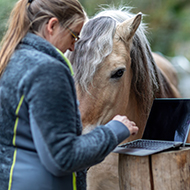Rare male fossa moves to Chester Zoo
Zaza (pictured) and Shala will spend much of their time apart.
A rare Malagasy fossa has been moved to Chester Zoo as part of a conservation programme to save the highly threatened species.
Zaza, a seven-year-old male fossa, travelled from San Diego Zoo after being selected as a genetic match for Chester Zoo's female fossa Shala.
The fossa is native to Madagascar, where it is the largest natural predator. They are closely related to the mongoose, but have retractable claws like cats.
However, as a result of mass deforestation in Madagascar, the species has become highly threatened. It is now estimated that there are fewer than 2,500 fossas living in the wild.
The International Union for the Conservation of Nature (IUCN) lists the species as vulnerable to extinction.
Zaza's move to Chester Zoo forms part of a global conservation breeding programme to save the species. It is hoped that Zaza and Shala will contribute to the survival of their species by having pups.
Fossa live solitary lives, and so Zaza and Shala will spend much of their time apart.
During the first stage of their introduction, zookeepers will rotate them separately through different habitats, giving them the opportunity to smell each other. They will also be able to see each other through a glass window and a slideable screen, without being able to get to one another.
For the conservation project to work, the two fossa must be introduced at precisely the right moment. This is because female fossa only come into season once a year, for a two-week period.
Jack Cunningham, a keeper in the carnivore team at the zoo, said: “They’re usually a silent species, except for when the females are looking for males, and then they will vocalise.
“After a few days of soft introductions through the windows and mesh, we’ll know Shala is ready to meet Zaza because she will stand at the top of a tree and scream, which is her way of saying: I’m ready!”
Shala has previously had a litter of pups at Chester Zoo with her last mate, Isalo, who will be moving zoos himself as part of the breeding programme. The litter of pups have already found new homes in the UK and abroad.
Her mating call has also played its part in improving scientific knowledge of the species.
Researchers recorded the call and analysed it to create a spectrogram – a visual representation of the sound. It is being used in the Madagascan rainforest to identify female fossas looking for mates in the wild.
This not only helps researchers in tracking species numbers, but also helps identify their preferred environments.
Speaking about Shala, Mr Cunningham added: “She was a wonderful mum to her first pups, so we’re excited to see if she and Zaza have their own litter.”
Image © Chester Zoo



 With Strangles Awareness Week just around the corner (5-11 May), vets are being encouraged to share a survey about the disease with their horse-owning clients.
With Strangles Awareness Week just around the corner (5-11 May), vets are being encouraged to share a survey about the disease with their horse-owning clients.